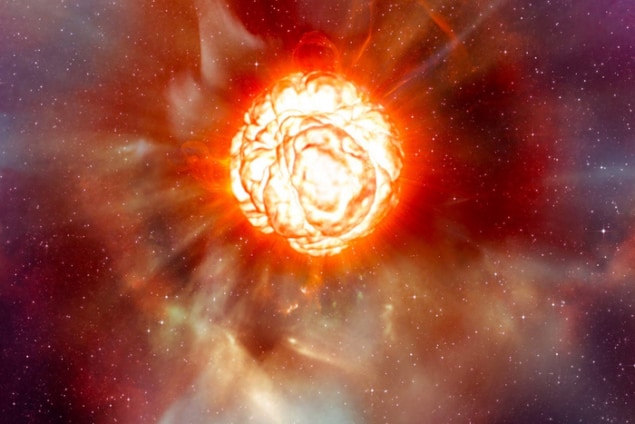
Massive stars in their “red supergiant” phase become around 100 times fainter in the visible part of the electromagnetic spectrum in the last few months before they collapse and explode as a supernova. This is the finding of researchers from Liverpool John Moores University in the UK and the University of Montpelier in France, who simulated what a massive star would look like just before it blows up and when it is nestled in its pre-explosion “cocoon”. The work could help astrophysicists figure out what causes these stars to explode, as well as enabling astronomers to catch the explosion in action.
Massive stars are defined as those that are eight to 20 times heavier than the Sun. In the last phase of their lives, such stars expand and cool to become red supergiants (RSGs). According to recent observations, most pre-RSG stars may be enshrouded in large amounts of circumstellar material (CSM), and this material may then be ejected by the star in the run-up to going supernova. It is unclear, however, over what timescale the CSM would accumulate. Would it form over several decades thanks to a so-called “superwind”? Or would it take less than a year via a brief outburst?
Simulating the visible spectra for pre-explosion RSGs
To shed light on this mystery, researchers led by Ben Davies of Liverpool John Moores simulated the visible spectra for RSGs just before they blow up and when they are surrounded by the pre-explosion CSM. They found that these stars should be barely visible shortly before they explode because the CSM absorbs virtually all light at visible wavelengths. “The dense CSM almost completely obscures the star, making it 100 times fainter in the visible part of the electromagnetic spectrum,” Davies explains. “This means that the day before the star explodes, it would be almost undetectable.”
Telescope archives are full of images that randomly contain massive stars that have since gone supernova, he adds. For example, researchers surveying a nearby galaxy for old stars could have accidentally imaged a RSG that then went on to explode a few years later. In these pre-explosion images, the soon-to-be-dead stars look big and bright, as massive stars always do, which means they cannot yet have built up the predicted circumstellar cocoon.
“This tells us that in the last years of the star’s life, it goes from being very bright to virtually invisible in a matter of months,” he tells Physics World. “This is the signature that the supernova is imminent and suggests that the cocoon is built up in less than a year, which is very fast.”
Superwind model can be excluded
The result also means that the superwind model can be excluded, he says, since in this case, RSGs would be obscured for decades before they explode.

How Betelgeuse blew its top and lost its rhythm
The new work, which is detailed in Monthly Notices of the Royal Astronomical Society, could help optimize how future facilities like the Vera Rubin Observatory, which is due to come online in the next few years, search for massive stars. “Such programmes will survey a huge fraction of the sky every few nights and so monitor billions of stars, including thousands of RSGs,” Davies explains. “If one of these RSGs starts to dramatically dim, we could trigger an alert to start observing the star more carefully. This will be the first step in figuring out what causes these pre-explosion outbursts.”
